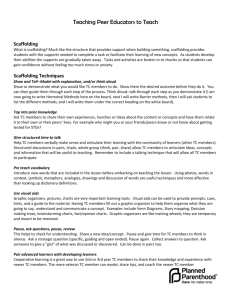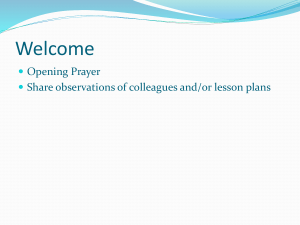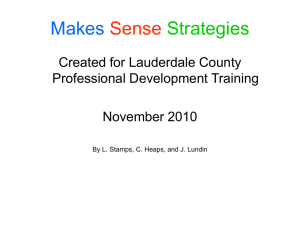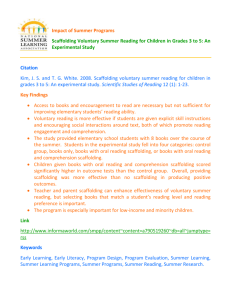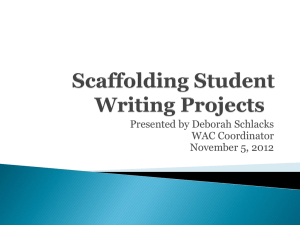Document 10466881
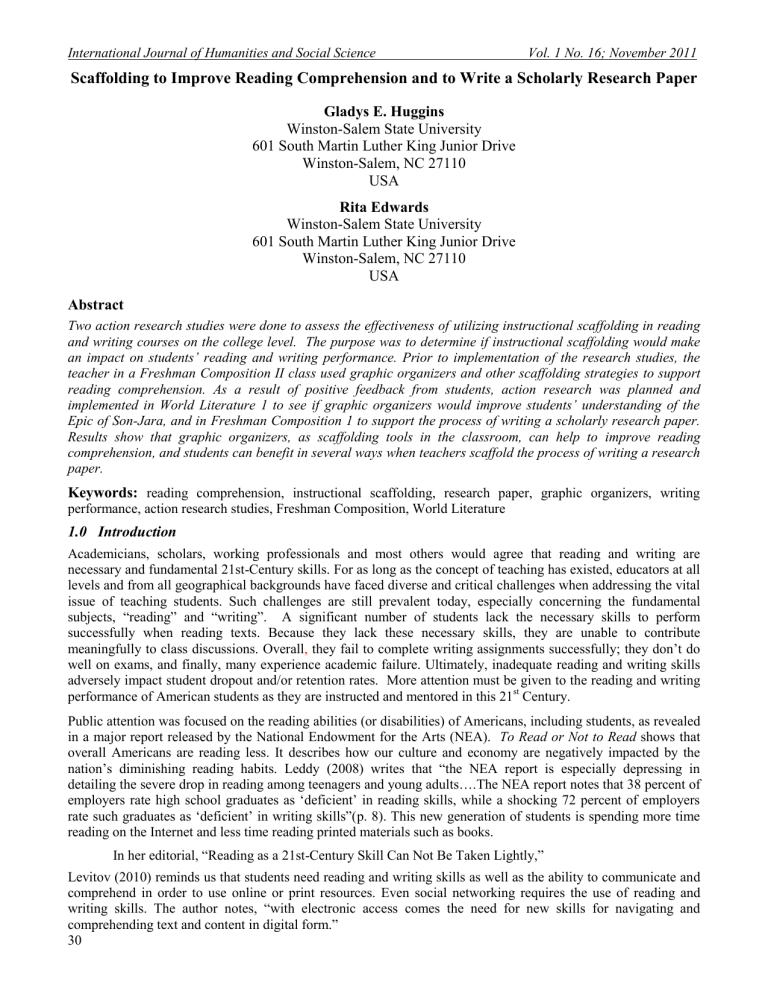
International Journal of Humanities and Social Science Vol. 1 No. 16; November 2011
Scaffolding to Improve Reading Comprehension and to Write a Scholarly Research Paper
Gladys E. Huggins
Winston-Salem State University
601 South Martin Luther King Junior Drive
Winston-Salem, NC 27110
USA
Rita Edwards
Winston-Salem State University
601 South Martin Luther King Junior Drive
Winston-Salem, NC 27110
USA
Abstract
Two action research studies were done to assess the effectiveness of utilizing instructional scaffolding in reading and writing courses on the college level. The purpose was to determine if instructional scaffolding would make an impact on students’ reading and writing performance. Prior to implementation of the research studies, the teacher in a Freshman Composition II class used graphic organizers and other scaffolding strategies to support reading comprehension. As a result of positive feedback from students, action research was planned and implemented in World Literature 1 to see if graphic organizers would improve students’ understanding of the
Epic of Son-Jara, and in Freshman Composition 1 to support the process of writing a scholarly research paper.
Results show that graphic organizers, as scaffolding tools in the classroom, can help to improve reading comprehension, and students can benefit in several ways when teachers scaffold the process of writing a research paper.
Keywords:
reading comprehension, instructional scaffolding, research paper, graphic organizers, writing performance, action research studies, Freshman Composition, World Literature
1.0
Introduction
Academicians, scholars, working professionals and most others would agree that reading and writing are necessary and fundamental 21st-Century skills. For as long as the concept of teaching has existed, educators at all levels and from all geographical backgrounds have faced diverse and critical challenges when addressing the vital issue of teaching students. Such challenges are still prevalent today, especially concerning the fundamental subjects, “reading” and “writing”. A significant number of students lack the necessary skills to perform successfully when reading texts. Because they lack these necessary skills, they are unable to contribute meaningfully to class discussions. Overall , they fail to complete writing assignments successfully; they don‟t do well on exams, and finally, many experience academic failure. Ultimately, inadequate reading and writing skills adversely impact student dropout and/or retention rates. More attention must be given to the reading and writing performance of American students as they are instructed and mentored in this 21 st
Century.
Public attention was focused on the reading abilities (or disabilities) of Americans, including students, as revealed in a major report released by the National Endowment for the Arts (NEA). To Read or Not to Read shows that overall Americans are reading less. It describes how our culture and economy are negatively impacted by the nation‟s diminishing reading habits. Leddy (2008) writes that “the NEA report is especially depressing in detailing the severe drop in reading among teenagers and young adults….The NEA report notes that 38 percent of employers rate high school graduates as „deficient‟ in reading skills, while a shocking 72 percent of employers rate such graduates as „deficient‟ in writing skills”(p. 8). This new generation of students is spending more time reading on the Internet and less time reading printed materials such as books.
In her editorial, “Reading as a 21st-Century Skill Can Not Be Taken Lightly,”
Levitov (2010) reminds us that students need reading and writing skills as well as the ability to communicate and comprehend in order to use online or print resources. Even social networking requires the use of reading and writing skills. The author notes, “with electronic access comes the need for new skills for navigating and comprehending text and content in digital form.”
30
© Centre for Promoting Ideas, USA www.ijhssnet.com
In this new millennium, educators face challenges as they commit themselves to help prepare students to enter a global, competitive society. There are times when educators find themselves using instructional strategies they have never used before, or modifying strategies already used to accommodate a new group of students with unique qualities. Instructional scaffolding, an old concept with a new name, can be modified and used in diverse ways across disciplines. Two action research studies were done in the fall semester of 2009, in different college classrooms by different instructors, to help determine if instructional scaffolding would make an impact on students‟ reading and writing performance. The use of graphic organizers as tools to help teach reading in World
Literature 1, and the process of scaffolding a research paper in Freshman Composition 1 were examples of modifying instructional strategies to guide student learning. An instructional scaffolding strategy was used briefly the prior (spring) semester as a type of pilot study or experiment. Students were guided in using graphic organizers to complete a reading assignment in Freshman Composition II, a composition class with a focus on literary works. The experiment was repeated in Freshman Composition II the fall semester of 2009. A summary of observations from the brief study will be given in this article, followed by detailed discussions of the two action research projects.
2.0
Instructional Scaffolding: Using Graphic Organizers to Guide Students in Comprehending Texts
Instructional scaffolds are similar to the scaffolding used in construction to support workers as they work on specific tasks. Put in place as temporary support structures, they assist students in accomplishing new concepts and tasks they could not usually achieve on their own (“Instructional Scaffolding,” 2002). Larkin writes, “Using scaffolded instruction optimizes student learning by providing a supportive environment while facilitating student independence. The concept of scaffolding (Bruner, 1975) is based on the work of Vygotsky, who proposed that with an adult's assistance, children could accomplish tasks that they ordinarily could not perform independently”
(2002). Using instructional scaffolds to help develop reading comprehension in English classes provide the support, assistance, and the confidence students need to read and to comprehend effectively.
2.1 Reading and Comprehending Poetry
Freshman Composition II is a writing course with an emphasis on reading, analyzing, and writing about literary works. In this course a pre-course writing assessment is administered each semester, beginning on the second day the class meets. Students are required to read two brief literary works and to write a literary critical analysis or a comparison/contrast essay of approximately 450 words, using instructions provided to them. When reading these essays, teachers observe students‟ strengths and weaknesses in the areas of reading comprehension/critical reading, analyzing, and writing. “Salvation” by Langston Hughes and “In Church” by Thomas Hardy are sometimes the two assigned literary works for the pre-course writing assessment. Of the two, teachers have observed that many students don‟t fully comprehend the very brief poem, “In Church.” In the spring and the fall of 2009, in Freshman Composition classes, instructional scaffolding was used to determine if it would have an effect on student comprehension of the poem. Activities included giving students a graphic organizer so they could organize their thoughts, reading the poem aloud, engaging students in dialog as the students defined terms, asking probing questions, making a few interpretive remarks, and having students to re-read the poem and record facts and conclusions on the graphic organizer. These are examples of probing questions that were asked as the teacher guided the discussion:
1.
To whom does Hardy refer in the first three lines: he ends, his voice, he bows and bends?
2.
What does, “his voice thrills up to the topmost tile” mean? Consider the meaning of your two words: topmost and tiles.
3.
What does, “each listener chokes” mean? Do they fall down and die?
4.
How does emotion “pervade the aisles”?
Students were then asked to explain what happens in the next few lines of the poem.
In summary, students‟ verbal responses and written feedback revealed that during the scaffolding activity, students gained a better understanding of the poem. The graphic organizer, a type of scaffold, encouraged students to think about information in new ways. As a result of positive feedback from students in Freshman Composition
II, action research was planned and implemented in World Literature 1 to see if graphic organizers would improve students‟ understanding of the
Epic of Son-Jara , a much longer literary work.
2.2 Action Research Project #1- Reading The Epic of Son- Jara
World Literature 1 is a core requirement that focuses on critical reading, critical writing and critical thinking.
31
International Journal of Humanities and Social Science Vol. 1 No. 16; November 2011
Reading literary works such as Son-Jara is a required assignment and possibly the most complicated reading assignment for students. For this action research project, the teacher supported the process of reading by scaffolding the process. Action research methods consisted of carefully explaining the assignments, providing graphic organizers during the time students were reading the Epic of Son-Jara, administering a unit test at the end of the unit and administering the final exam at the end of the semester .
The research question was, “Will the use of instructional scaffolding in World Literature 1 improve students‟ reading comprehension skills?” All participants in the action research were students enrolled in World Literature 1. The experimental group met in a morning class while the control groups met either in the morning or afternoon.
2.3 Procedures
All students enrolled in four World Literature 1 classes were taught by the same instructor, read the same literary works, received the same number of out-of-class and in-class assignments (lectures, readings, study questions, journal writing, test development, essays, and group assignments) except for the utilization of graphic organizers by the experimental group, and they were evaluated by the same instrument.
The experimental group utilized instructional scaffolds -selected graphic organizers- when reading Son-Jara .
Before students were introduced to the literary work Son-Jara , each student was given a copy of a KWL graphic organizer to determine who, if anyone, knew any facts about the Epic of Son-Jara. That particular graphic organizer had three categories: 1) K-What do you know about the epic 2) W-What do you want to know about the work, and 3) L-What did you learn about the reading. Based on students‟ responses for category 1, 100% of the students were unfamiliar with the epic. Responses for category 2 revealed that 100% of the students were interested in knowing the purpose of studying Son-Jara , the types of conflict found in the work and the moral of the epic. One hundred percent of students responded to category 3 by stating what information had been learned after reading Son-Jara. The students responded with two or more sentences.
Here are some examples of responses to category 3.
Son-Jara has many praise names throughout the epic
I learned that Son-Jara is an African epic of the Manden people;
Son-Jara was exiled and could not walk for nine years;
Sumamuru was an evil and bad king;
Son-Jara was the second born, but was announced as the first born.
A second graphic organizer labeled “characterization” displayed six categories as follows: character‟s name, appearance, actions, thoughts, speech, and reaction from others. Students were asked to review episode one (a short episode) of Son-Jara and find any character‟s names listed. Once students were able to locate the first name, they were told to focus their attention on that name and then write that particular character‟s name under the column labeled character. Students were directed to provide any information relevant to those six categories.
After they completed information for the initial character, they followed the same procedure for other characters in episode one and recorded that information under the proper heading. Guidance was provided to students for approximately 20 minutes allowing them ample time to grasp the process. Upon realizing students were able to work independently, support was withdrawn.
A third graphic organizer utilized by students was a story map in which students completed information based on setting, characters, problems, events and solutions. Students were directed to write the title Son-Jara on the first line and information pertaining to the setting for a part of episode three. They were then given further instructions to continue providing information for the remaining categories, using class time to complete the task.
A fourth graphic organizer required information related to cause and effect. Students were given the option to select a part from the epic in which they were interested in discussing in more detail. They were required to state an event and show the cause created by that event. The majority of the class decided to display information pertaining to Son-Jara‟s birth announcement and the problems created due to the messenger delivering an incorrect message.
When the class completed the study of Son-Jara , they were given a unit test based on the literary work. The test consisted of four fill-in the-blank questions, 15 matching questions pertaining to characters, three questions related to theme, three questions related to setting, 10 questions related to plot and four questions related to connections with fairytales and today‟s culture.
32
© Centre for Promoting Ideas, USA www.ijhssnet.com
2.4 Results and Observations
The experimental group scored lower on the unit test compared to the controlled group of students that were not introduced to the scaffolding process. The average for the experimental group was 82.52 compared to the average
87.30 for the control group. This probably can be attributed to the day and time the experimental group met. It was discovered that students from the experimental group shared test information with students who were enrolled in classes at a later time on the same day and classes held the following day. At the end of the semester, the teacher administered the final exam which included 24 multiple choice questions for the literary work Son-
Jara.
The mean score for the experimental group was 84.6 which is a slightly higher score compared to 82.6 for the controlled group.
2.5 Discussion
Several graphic organizers were used to determine if scaffolding actually assisted students with reading and comprehending the literary work Son-Jara . Based on the final examination, students who were introduced to graphic organizers scored slightly higher than students who did not use the scaffolding process; however, the unit test scores did not display that the scaffolding process made a difference. The experimental group scored lower than the control group on the unit test which can be attributed to the sharing of information by students in the experimental group with students whose classes were held later in the day and on another day.
3.0
Action Research Project #2: Writing a Scholarly Research Paper
Freshman Composition I, a core requirement, focuses on reading, writing and thinking skills. The action research project involved scaffolding the process of writing a research paper for first year college students. Since writing a research paper is an English course requirement, the major objective was to provide support for students as they completed this requirement. Students were supported through instructional scaffolding in the classroom so they could “complete the process of writing a scholarly research paper in a timely manner.” Forty-five, first semester college freshmen agreed to participate in the study. These students had successfully and voluntarily enrolled in
Freshman Composition during the registration and/or add-drop period. The research project was presented to all students in class on a designated day, and students who wanted to participate signed an informed consent form.
3.1 Research Focus
The project was guided by the research question; “Will the use of instructional scaffolding in Freshman
Composition 1 support the process of writing a research paper?” In evaluating students‟ research papers since
2004, the teacher had observed year after year that many students do not seem to know how to write a scholarly research paper. Of the papers received, usually the average grade earned was C, even after revisions had been made and after, at times, consideration was given for progress made in completing the research assignment. The intent was to see if additional support provided during this action research project would help students to write a more scholarly paper. The desired outcome was that instructional scaffolding would help students to understand, organize, and complete the process of writing a research paper successfully.
3.2 Research Methods
Writing a 10 page research paper is perhaps one of the most difficult and time consuming assignments for first year college students. In Freshman Composition 1, the scaffolding process consisted of two phases with several steps: 1.) writing a mini (5 page) paper, and 2.) building upon the mini paper to produce a longer (10 page) research paper. Each assignment built upon the previous one, presumably making the entire process more manageable and less difficult. Action research steps consisted of collecting pre-assessment data, carefully explaining the assignment and providing models and/or support information, scheduling and attending library instructional sessions and administering post test on library information, collecting and reviewing outlines with thesis statements, work cited pages, and article reviews for mini paper; facilitating a peer review, collecting and evaluating mini research papers, collecting and reviewing outlines with thesis statements, work cited pages, and article reviews for final paper; and collecting and evaluating final research papers.
Collecting pre-assessment data was done using a survey. The survey gauged the comfort level of students when using library resources, and it assessed how students perceived their library skills before participating in library instructional sessions. Zomerang was used to create the brief, 10 item survey. Carefully explaining the assignment and providing models and/or support information involved giving the students a research paper packet consisting of the assignment, suggested hot topics/issues, guidelines/scoring rubric, a template for an article review, information on writing an outline and a thesis statement, a list of attribution words and phrases, tips on integrating literature, a list of transitional words and phrases, and a web link to a model research paper.
33
International Journal of Humanities and Social Science Vol. 1 No. 16; November 2011
Scheduling and attending library instructional sessions with students and administering a post test on library information were done in collaboration with two of the school‟s librarians. Sessions were on plagiarism,
MLA, and research skills. Students received handouts and/or website links to MLA so they would know how to format their research paper, including the works cited page. Students scheduled an appointment with a library research assistant for individualized assistance in finding scholarly sources . Collecting and reviewing outlines with thesis statements, work cited pages, and article reviews for mini paper occurred after students had an opportunity to meet with a library assistant. Facilitating a peer review allowed the teacher to give students the opportunity to provide critical feedback, using guidelines/scoring rubric and to receive critical feedback . Students were encouraged to go to the writing center. Collecting mini research papers was done the class session following the peer review. The process of collecting and reviewing outlines with thesis statements, work cited pages, and article reviews for final papers was done, and the teacher discussed how to build upon the mini paper to write the 10 page research paper. The final research paper was then collected and evaluated.
3.3
Data Collection and Findings
Collecting pre-assessment data was done using a brief 10 item Zomerang survey . The survey reported that of the
35 students who completed the survey, 54% knew how to locate scholarly books and printed journals in the library; 46% knew how to locate online scholarly information and peer-reviewed journals; 83% reported knowing how to evaluate written material; 34% knew what it meant to synthesize and integrate research information; 100% knew how to document using MLA. In response to question #8: (Overall how comfortable do you feel using the library?) only 9% chose very comfortable; 69% chose comfortable, and 22% chose not very comfortable. Overall
82% of the 35 students reported they were confident in their researching abilities. A post assessment, quiz on library information after students had attended all library instructional sessions, was administered. The quiz consisted of 25 multiple choice items that assessed students‟ understanding of information covered. Students were asked questions about plagiarism, databases where students could find scholarly or peer reviewed articles and articles on current hot topics, questions about MLA, and questions about evaluating websites. The average score of 42 participants was 84%.
In reviewing students‟ grades on the final research project, the average grade was 80/C. Individual research papers showed that students had common problems with writing a good thesis statement and developing the paper. Of course, if there is no clear thesis statement, it is impossible to write and develop a good paper. Students made obvious attempts to integrate sources, in most cases, using attribution verbs.
According to the pre-assessment, 34% of participants reported knowing what it means to synthesize and integrate research information; 83% reported knowing how to evaluate written material. Near the end of the project, students were asked to consider what they had learned from library instructional sessions and from research on the concepts, evaluate and integrate , and to write a response to the following two items: 1.) Explain what it means to evaluate material that you read when working on your research paper, and 2.) What does it mean to integrate sources? Forty-five participants responded. Based on responses given, twenty-five students (or nearly 56%) really understood what it means to evaluate sources. This shows a significant difference in the 83% of students who reported knowing how to evaluate written material on the pre-survey. Also on the pre survey, 34% reported they know what it means to synthesize and integrate research information. Based on responses given to the question about integrating sources, twenty-nine students (or 64%) really understood what it means to integrate sources. It appears that some students who responded on the pre survey that they knew how to evaluate material really did not know. It also appears that as a result of instructional scaffolding, many students learned what it means to integrate sources, and they made a strong attempt to do so in their research papers.
3.4 Discussion
Did the use of instructional scaffolding in Freshman Composition 1 support the process of writing a research paper? Although grades on the research paper assignment did not increase significantly from prior semesters, instructional scaffolding did support students in English classes. As a result of scaffolding the process of writing a research paper, students developed a better understanding of what it means to locate and to integrate scholarly.
They also learned how to organize their time and resources. Overall, most students were able to complete the assignment successfully. Approximately ninety-six percent of participants (43 of 45) completed the process of writing a research paper. Based on reflections of previous semesters, this represented an increase.
34
© Centre for Promoting Ideas, USA www.ijhssnet.com
As compared to students in previous Freshman Composition classes, scores earned on the research paper assignment were about the same. The average score was 80/C; however, considering that students were expected to produce a “scholarly” research paper using peer reviewed articles, this could suggest that a grade of C earned for this project carried more weight than the average grade of C earned in previous semesters when peer reviewed articles weren‟t emphasized as much. Overall, better documentation of sources was done, both parenthetically and on the works cited page. Better integration of sources was attempted with the use of attribution verbs, and more scholarly sources were used. In the past, for this assignment, students were not asked to read and integrate information from as many peer reviewed journals. In assessing papers, it was obvious that students had problems comprehending information from scholarly sources. Although such sources were cited within the body of papers and on works cited pages, in many instances, students failed to adequately interpret and integrate sources. It is possible that there is a correlation between this and the fact that some of the participants were enrolled in a developmental reading course offered at the university.
3.5 Reflections
Students were asked to reflect informally throughout the process, and to use their reflections for self improvement. They were to think about what they had done at various stages in order to make connections and to informally assess their progress. In addition, a final assignment required students to reflect and to write. Students had varied responses about the researching and writing process:
The research project was a challenge for me because I find that this project is not interesting to me at all.
Working one-on-one with the library advisors was a big help for me.
The part that has been the most challenging was finding articles for my topic.
The process we used for this research paper was very new to me. The scholarly journals really helped when it was time to write the outline.
In the past years I have always used topic outlines, never sentence outlines, but when it was time to write the paper, it helped.
Researching information for a research topic is nothing new to me. However, using scholarly sources, and doing article reviews on them is a technique that is very new to me. It seems that this new technique really helped me while writing my paper.
One problem that I have is narrowing down my topic, because there are so many things you can write about when it comes to healthcare.
I have found it quite difficult; I had to learn many things like look up scholarly sources instead of using web pages.
I learned more about in-text citations and how to write an article review.
This research paper required a lot of time and effort before I began to write the paper.
I have never met with a librarian before in order to get tips/suggestions on writing a paper. Meeting with her was very helpful.
I never knew how to access articles online. We learned about citing a source and plagiarism. I know that all of this will be very beneficial to me.
I found the research part of the research paper somewhat overwhelming.
After doing article reviews, I found they did help some in writing my paper.
The research writing process was not that difficult for me. I enjoyed the writing process.
The research paper assignment was very interesting. It was also a very good learning experience.
For me writing the article reviews was the hardest part, but it made writing my paper very easy.
My research paper was very time consuming. I found it very difficult to find inspiration and motivation to work on my paper.
This has been a learning experience for me. A lot of things required for this research paper were new to me.
This is a learning process that I will never forget and I will always appreciate.
I am proud of myself because I learned how to pace myself for this research paper.
Students described the process in a number of ways: uninteresting, challenging, helpful, new, difficult, time consuming, interesting, overwhelming. A major goal for using instructional scaffolding in the classroom is to provide temporary support for students to assist them in accomplishing tasks.
35
International Journal of Humanities and Social Science Vol. 1 No. 16; November 2011
In Freshman Composition 1, despite support provided, students seemed to struggle to complete tasks in a timely manner. Perhaps fewer steps would have made the process easier for students. Meeting with a librarian to receive assistance in choosing scholarly sources and writing article reviews were quite helpful as reported by students; they are scaffolding techniques that should be continued. Some steps might be modified or discontinued.
4.0 Conclusion
Instructional scaffolding, as noted earlier, is an old concept with a new name. Most teachers have used scaffolding activities in the classroom in one or more ways. Research suggests that providing assistance and support to students through instructional scaffolding optimizes student learning. Educators will always be challenged to effectively teach students in order to optimize student learning. In an era when there is a decrease in the number of Americans reading, a tremendous challenge is to encourage students to read. Often the desire to read relates to a reader‟s connection to the reading material. Additionally, to read effectively is to comprehend. Students have to connect to their texts in order to comprehend them. In the first action research study, there is evidence to show that graphic organizers, as scaffolding tools in the classroom, can help to improve reading comprehension by helping students to connect to their texts. The second action research study shows that students can benefit in several ways when teachers scaffold the process of writing a research paper. From reading a simple poem to a complex epic, writing a simple narrative to a complex scholarly research paper, scaffolding tools can have positive effects on reading and writing performance.
References
(2008, November 24). Instructional scaffolding to improve learning. Retrieved from Faculty Development and
Instructional Design website: http://www.niu.edu/spectrum/2008/fall/scaffolding.shtml
Larkin, M. (2002). Using scaffolded instruction to optimize learning. Council for Exceptional Children .
Leddy, C. (2008). The 'alarming state of reading in america. Writer , 121 (5).
Levitov, D. D. (2010). Reading as a 21st-century skill cannot be taken lightly. School Library .
36
